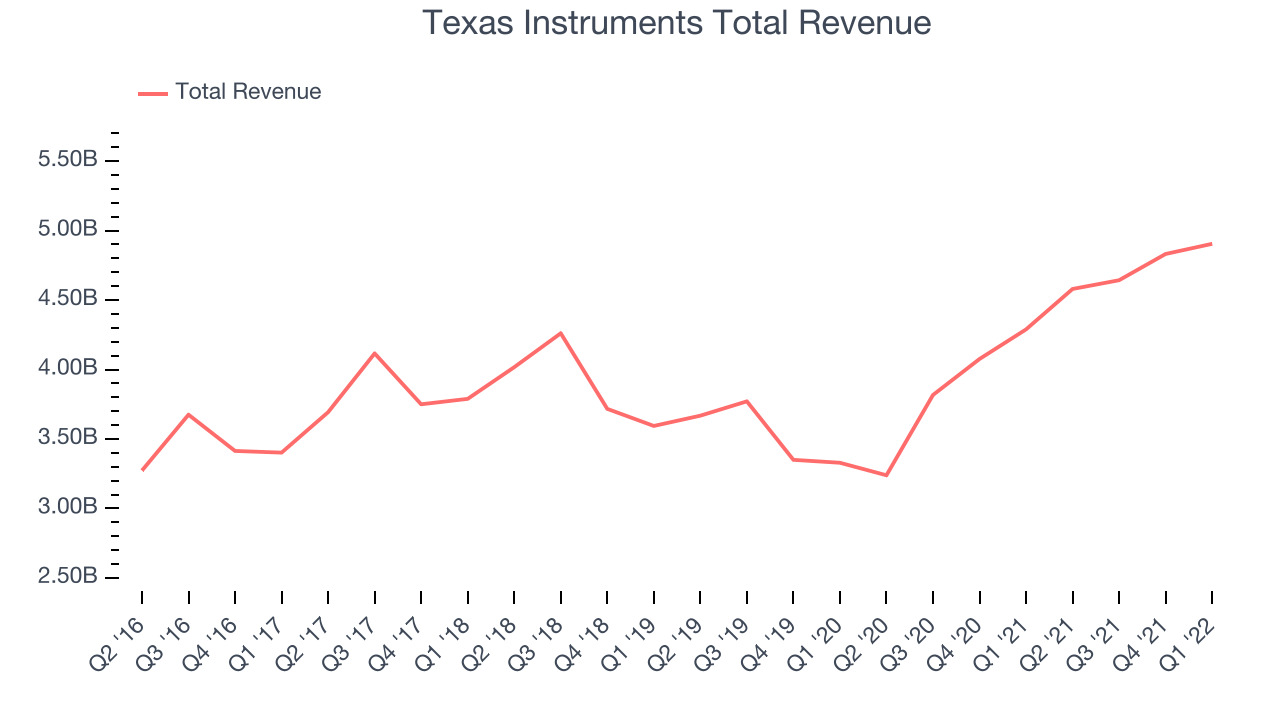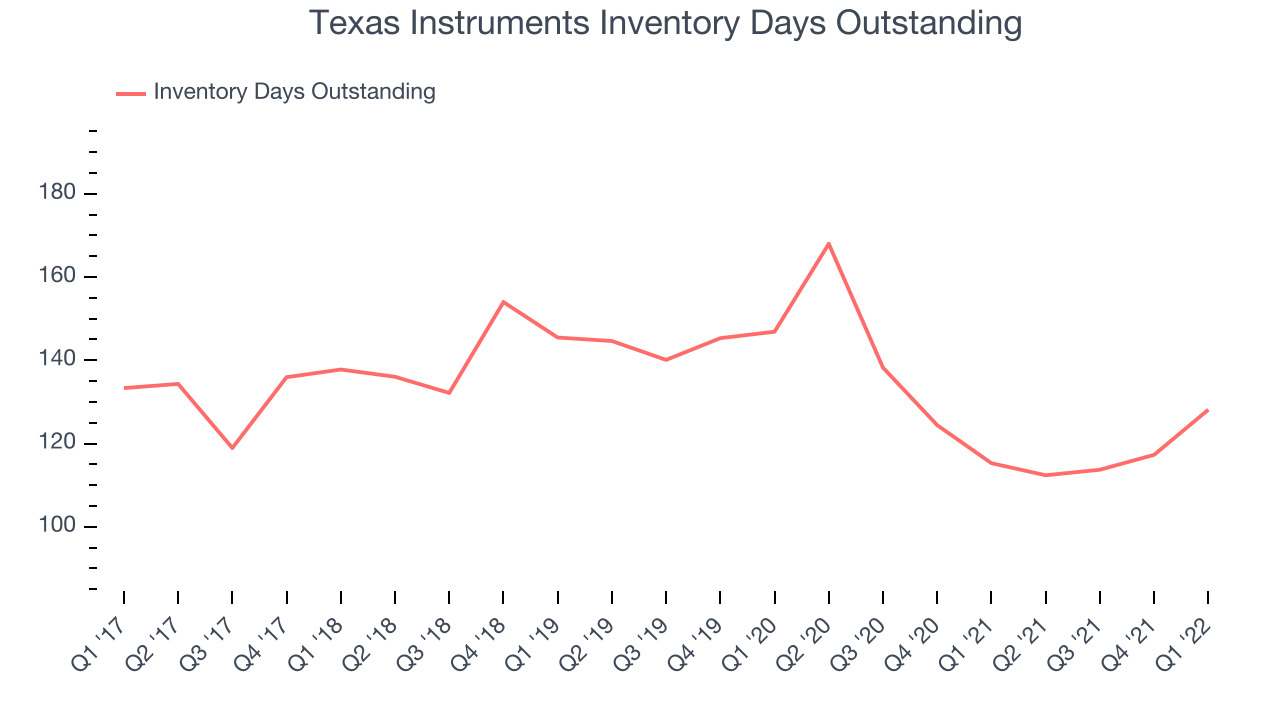Analog chip manufacturer Texas Instruments (NASDAQ:TXN) announced better-than-expected results in the Q1 FY2022 quarter, with revenue up 14.3% year on year to $4.9 billion. However, guidance for the next quarter was less impressive, coming in at $4.5 billion at the midpoint, being 9.2% below analyst estimates. Texas Instruments made a GAAP profit of $2.2 billion, improving on its profit of $1.75 billion, in the same quarter last year.
Is now the time to buy Texas Instruments? Access our full analysis of the earnings results here, it's free.
Texas Instruments (TXN) Q1 FY2022 Highlights:
- Revenue: $4.9 billion vs analyst estimates of $4.73 billion (3.65% beat)
- EPS (GAAP): $2.35
- Revenue guidance for Q2 2022 is $4.5 billion at the midpoint, below analyst estimates of $4.95 billion
- Free cash flow of $1.7 billion, up 58.2% from previous quarter
- Inventory Days Outstanding: 128, up from 117 previous quarter
- Gross Margin (GAAP): 70.1%, up from 65.2% same quarter last year
Headquartered in Dallas, Texas since the 1950s, Texas Instruments (NASDAQ: TXN) is the world’s largest producer of analog semiconductors.
Demand for analog chips is generally linked to the overall level of economic growth, as analog chips serve as the building blocks of most electronic goods and equipment. The biggest secular growth drivers currently are the adoption of electric vehicles, 5G networks and Internet of Things connectivity, and demand for chips that reduce power consumption. Unlike digital chip designers, analog chip makers tend to produce the majority of their own chips, as analog chip production does not require expensive leading edge nodes. Less dependent on major secular growth drivers, analog product cycles are much longer, often 5-7 years.
Sales Growth
Texas Instruments's revenue growth over the last three years has been unremarkable, averaging 8.21% annually. But as you can see below, last year has been stronger for the company, growing from quarterly revenue of $4.28 billion to $4.9 billion. Semiconductors are a cyclical industry and long-term investors should be prepared for periods of high growth, followed by periods of revenue contractions (which can sometimes offer opportune times to buy).

While Texas Instruments beat analysts' revenue estimates, this was a very slow quarter with just 14.3% revenue growth. This was the third straight quarter of decelerating growth for Texas Instruments, potentially indicating a coming cycle downturn.
Texas Instruments's revenue growth has slowed for the last three quarters and the company expects growth to turn negative next quarter guiding to a 1.75% year on year decline, but analyst think it will recover next year, as consensus NTM revenues are forecast to grow 6.6%.
There are others doing even better than Texas Instruments. Founded by ex-Google engineers, a small company making software for banks has been growing revenue 90% year on year and is already up more than 150% since the IPO last December. You can find it on our platform for free.
Product Demand & Outstanding Inventory
Days Inventory Outstanding (DIO) are an important metric for chipmakers, as it reflects the capital intensity of the business and the cyclical nature of semiconductor supply and demand. In a tight supply environment, inventories tend to be stable, allowing chipmakers to exert pricing power. Steadily increasing DIO can be a warning sign that demand is weak, and if inventories continue to rise the company may have to downsize production.

This quarter, Texas Instruments’s inventory days came in at 128, 6 days below the five year average, showing that despite the recent increase there is no indication of an excessive inventory buildup at the moment.
Key Takeaways from Texas Instruments's Q1 Results
Sporting a market capitalization of $160 billion, more than $9.82 billion in cash and with positive free cash flow over the last twelve months, we're confident that Texas Instruments has the resources it needs to pursue a high growth business strategy.
We enjoyed seeing Texas Instruments’s improve their gross margin materially this quarter. And we were also glad to see the improvement in operating margin. On the other hand, it was unfortunate to see that the revenue guidance for the next quarter missed analysts' expectations and inventory levels increased. Overall, it seems to us that this was a complicated quarter for Texas Instruments. The company is down 6.8% on the results and currently trades at $157 per share.
Should you invest in Texas Instruments right now? It is important that you take into account its valuation and business qualities, as well as what happened in the latest quarter. We look at that in our actionable report which you can read here, it's free.
One way to find opportunities in the market is to watch for generational shifts in the economy. Almost every company is slowly finding itself becoming a technology company and facing cybersecurity risks and as a result, the demand for cloud-native cybersecurity is skyrocketing. This company is leading a massive technological shift in the industry and with revenue growth of 70% year on year and best-in-class SaaS metrics it should definitely be on your radar.
The author has no position in any of the stocks mentioned.
